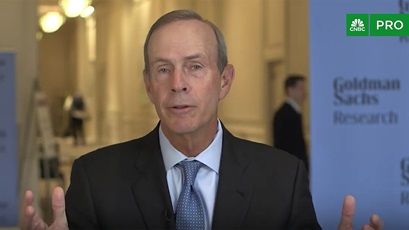emissions solutions
study recommends ways to expand hydrogen to help meet US climate goals
2 min read | may 28, 2024
Austin Knight (left), Chevron’s vice president of Hydrogen, and Mike Wirth, Chevron’s Chairman and CEO, discuss the new National Petroleum Council report at an April press conference.
A diverse committee of more than 200 experts from more than 100 energy industry, government, academic and environmental organizations recently spent two years responding to a request from U.S. Secretary of Energy Jennifer Granholm:
Determine how hydrogen can advance U.S. climate goals.
The committee, established by the National Petroleum Council (NPC) and chaired by Mike Wirth, Chevron’s Chairman and CEO, conducted a study and supervised the preparation of a report for the NPC’s review.
And on April 23, they released their more than 1,200-page report, which recommends ways to boost hydrogen solutions.
austin knight
vice president of hydrogen
why it matters
The U.S. wants to reach net-zero greenhouse gas emissions by 2050. Achieving this goal will require multiple tools and technologies.
Hydrogen from lower carbon sources, called low carbon intensity (LCI) hydrogen, could:
reduce U.S. carbon emissions by about
8%
by 2050
reduce the cost of reaching this goal by
$160–260 billion
annually
the highlights
The report includes 19 findings and makes 23 recommendations, which touch on:
- Policy and regulation: This includes developing legislation to bridge cost gaps between low carbon intensity hydrogen and more widespread fuels, increasing investor confidence and streamlining regulatory frameworks.
- Societal impacts and safety: This includes developing value chains that provide benefits to society, improving community engagement and enabling workforce development.
- Technology, research and development: This includes investing to close technology gaps, address technical bottlenecks and support public-private research programs.
mike wirth
chevron chairman and CEO
coordination and alignment
The study reflects the successful coordination of more than 200 voices, most from outside the oil and gas industry. These diverse perspectives were incorporated into the study and are reflected in the key findings. Ultimately, the study accomplishes an NPC goal: to deliver high-quality input to Secretary Granholm and the U.S. Department of Energy. Other government agencies can also use the recommendations when making decisions about hydrogen.

what’s next
Secretary Granholm has stated that hydrogen could help lower the carbon intensity of various industries. This report could provide guidance for policymakers, companies and others planning large-scale hydrogen projects.
Chevron is working to grow its hydrogen business. As an example, the company recently embarked on a lower carbon hydrogen production and storage project in Utah.
For more information about the study, read the NPC’s Harnessing Hydrogen: A Key Element of the U.S. Energy Future.
topics covered
related content
-

 chevron CEO discusses the future of energy
chevron CEO discusses the future of energyemissions solutionsjanuary 20, 2025
-

 novel ideas, established companies key to advancing lower carbon tech
novel ideas, established companies key to advancing lower carbon techemissions solutionsjanuary 14, 2025
-

 chevron CEO talks growing production, efficient spending
chevron CEO talks growing production, efficient spendingemissions solutionsdecember 18, 2024
-

 1st US hydrogen-powered passenger ferry open for business
1st US hydrogen-powered passenger ferry open for businessalternative fuelsaugust 23, 2024
chevron email updates
Subscribe to our newsletter to receive news and updates.



